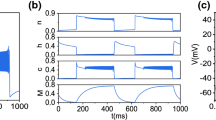Abstract
Recordings from cerebellar Purkinje cell dendrites have revealed that in response to sustained current injection, the cell firing pattern can move from tonic firing of Ca2+ spikes to doublet firing and even to quadruplet firing or more complex firing. These firing patterns are not modified substantially if Na+ currents are blocked. We show that the experimental results can be viewed as a slow transition of the neuronal dynamics through a period-doubling bifurcation. To further support this conclusion and to understand the underlying mechanism that leads to doublet firing, we develop and study a simple, one-compartment model of Purkinje cell dendrite. The neuron can also exhibit quadruplet and chaotic firing patterns that are similar to the firing patterns that some of the Purkinje cells exhibit experimentally. The effects of parameters such as temperature, applied current, and potassium reversal potential in the model resemble their effects in experiments. The model dynamics involve three time scales. Ca2+- dependent K+ currents, with intermediate time scales, are responsible for the appearance of doublet firing, whereas a very slow hyperpolarizing current transfers the neuron from tonic to doublet firing. We use the fast-slow analysis to separate the effects of the three time scales. Fast-slow analysis of the neuronal dynamics, with the activation variable of the very slow, hyperpolarizing current considered as a parameter, reveals that the transitions occurs via a cascade of period-doubling bifurcations of the fast and intermediate subsystem as this slow variable increases. We carry out another analysis, with the Ca2+ concentration considered as a parameter, to investigate the conditions for the generation of doublet firing in systems with one effective variable with intermediate time scale, in which the rest state of the fast subsystem is terminated by a saddle-node bifurcation. We find that the scenario of period doubling in these systems can occur only if (1) the time scale of the intermediate variable (here, the decay rate of the calcium concentration) is slow enough in comparison with the interspike interval of the tonic firing at the transition but is not too slow and (2) there is a bistability of the fast subsystem of the spike-generating variables.
Similar content being viewed by others

References
Bergé P, Pomeau Y, Vidal C (1984) Order Within Chaos. Cambridge University Press, Cambridge.
Bertram R, Butte MJ, Kiemel T, Sherman A (1995) Topological and phenomenological classification of bursting oscillations. Bull. Math. Biol. 57:413-439.
Bush PC, Sejnowski TJ (1991) Simulations of a reconstructed cerebellar Purkinje cell based on a simplified channel kinetics. Neural Comput. 3:321-332.
Chay TR, Rinzel J (1985) Bursting, beating and chaos in excitable membrane model. Biophysiol. J. 47:357-366.
Chialvo DR, Gilmour RF Jr, Jalife J (1990) Low-dimensional chaos in cardiac tissue. Nature 343:653-657.
Chialvo DR, Jalife J (1987) Non-linear dynamics of cardiac excitation and impulse propagation. Nature 330:749-752.
Denk W, Sugimori M, Llinás R (1995) Two types of calcium response limited to single spines in cerebellar Purkinje cells. Proc. Natl. Acad. Sci. USA 92:8279-8282.
De Schutter E, Bower M (1994) An active membrane model of the cerebellar Purkinje cell. I. Simulation of current clamps in slices. J. Neurophysiol. 71:375-400.
De Schutter E, Smolen P (1998) Calcium dynamics in large neuronal models. In: Koch C, Segev I, eds. Methods in Neuronal Modeling: From Ions to Networks, 2nd ed. MIT Press, Cambridge, MA. pp. 211-250.
Eilers J, Augustine GJ, Konnerth A (1995) Subthreshold synaptic Ca2+ signaling in fine dendrites and spines of cerebellar Purkinje neurons. Nature 373:155-158.
Etzion Y, Grossman Y (1998) Potassium currents modulation of calcium spike firing in dendrites of cerebellar Purkinje cells. Exp. Brain Res. 122:283-294.
Feigenbaum MJ (1979) The universal metric properties of nonlinear transformations. J. Stat. Physiol. 21:669-706.
Golomb D, Amitai Y (1997) Propagating neuronal discharges in neocortical slices: Computational and experimental study. J. Neurophysiol. 78:1199-1211.
Golomb D, Guckenheimer J, Gueron S (1993) Reduction of a channel based model for a stomatogastric ganglion LP neuron. Biol. Cyber. 69:129-137.
Golomb D, Wang XJ, Rinzel J (1996) Propagation of spindle waves in a thalamic slice model. J. Neurophysiol. 75:750-769.
Guckenheimer J, Holmes P (1983) Nonlinear Oscillations, Dynamical Systems, and Bifurcation of Vector Fields. Springer, New York.
Guckenheimer J, Labouriau IS (1993) Bifurcation of the Hodgkin and Huxley equations: A new twist. Bullet. Math. Biol. 55:937-952.
Hoppensteadt FC, Izhikevich EM (1997) Weakly Connected Neural Networks. Springer, New York.
Hounsgaard J, Midtgaard J (1988) Intrinsic determinants of firing pattern in Purkinje cells of the turtle cerebellum in vitro. J. Physiol. (Lond.) 402:731-749.
Hounsgaard J, Midtgaard J (1989) Synaptic control of excitability in turtle cerebellar Purkinje cells. J. Physiol. (Lond.) 409:157-170.
Jack JJ, Noble D, Tsien RW (1975) Electric Current Flow in Excitable Cells. Oxford University Press, London.
Jaeger D, Bower JM (1994) Prolonged responses in rat cerebellar Purkinje cells following activation of the granule cell layer: An intracellular in vitro and in vivo investigation. Exp. Brain Res. 100:200-214.
Johnston D, Wu SMS (1995) Foundation of Cellular Neurophysiology. MIT Press, Cambridge, MA.
Jung R, Kiemel T, Cohen AH (1996) Dynamic behavior of a neural network model of locomotor control in the lamprey. J. Neurophysiol. 75:1074-1086.
Kepler TB, Abbott LF, Marder E (1992) Reduction of conductance-based neuron models. Biol. Cyber. 66:381-387.
Kuramoto Y (1984) Chemical Oscillations, Waves and Turbulence. Springer, New York.
Lev-Ram V, Miyakawa H, Lasser-Ross N, Ross WN (1992) Calcium transients in cerebellar Purkinje neurons evoked by intracellular stimulation. J. Neurophysiol. 68:1167-1177.
Llinás R, Nicholson C (1971) Electrophysiological properties of dendrites and somata in alligator Purkinje cells. J. Neurophysiol. 34:532-551.
Llinás R, Sugimori M (1980) Electrophysiological properties of in vitro Purkinje cell dendrites in mammalian cerebellar slices. J. Physiol. (Lond.) 305:197-213.
Meunier C (1992) Two-and three-dimensional reductions of the Hodgkin-Huxley system: Separation of time scales and bifurcation schemes. Biol. Cyber. 67:461-468.
Miyakawa H, Lev-Ram V, Lasser-Ross N, Ross WN (1992) Calcium transients evoked by climbing fiber synaptic inputs in guinea pig cerebellar Purkinje neurons. J. Neurophysiol. 68:1178-1189.
Rapp M, Segev I, Yarom Y (1994) Physiology, morphology and detailed passive models of guinea-pig cerebellar Purkinje cells. J. Physiol. (Lond.) 474:101-118.
Rinzel J, Ermentrout GB (1998) Analysis of neural excitability and oscillations. In: Koch C, Segev I, eds. Methods in neuronal modeling: From ions to networks, 2nd ed. MIT Press, Cambridge, MA. pp. 251-291.
Ross WN, Lasser Ross N, Werman R (1990) Spatial and temporal analysis of calcium-dependent electrical activity in guinea pig Purkinje cell dendrites. Proc. R. Soc. Lond. B Biol. Sci. 240:173-185.
Schuster HG (1989) Deterministic Chaos. VCH Verlagsgesellschaft, Weinheim, F.R.G.
Strogatz SH (1994) Nonlinear Dynamics and Chaos. Addison Wesley, Reading, MA.
Tabak J, Senn W, O'Donovan MJ, Rinzel J (2000) Modeling of spontaneous activity in developing spinal cord using activity-dependent depression in an excitatory network. J. Neurosci. 20:3041-3056.
Usowicz MM, Sugimori M (1992) P-type calcium channels in the somata and dendrites of adult cerebellar Purkinje cells. Neuron 9:1185-1199.
Wang, XJ (1999) Fast burst firing and short-term synaptic plasticity: A model of neocortical chattering neurons. Neurosc. 89:347-362.
Author information
Authors and Affiliations
Rights and permissions
About this article
Cite this article
Mandelblat, Y., Etzion, Y., Grossman, Y. et al. Period Doubling of Calcium Spike Firing in a Model of a Purkinje Cell Dendrite. J Comput Neurosci 11, 43–62 (2001). https://doi.org/10.1023/A:1011252730249
Issue Date:
DOI: https://doi.org/10.1023/A:1011252730249



